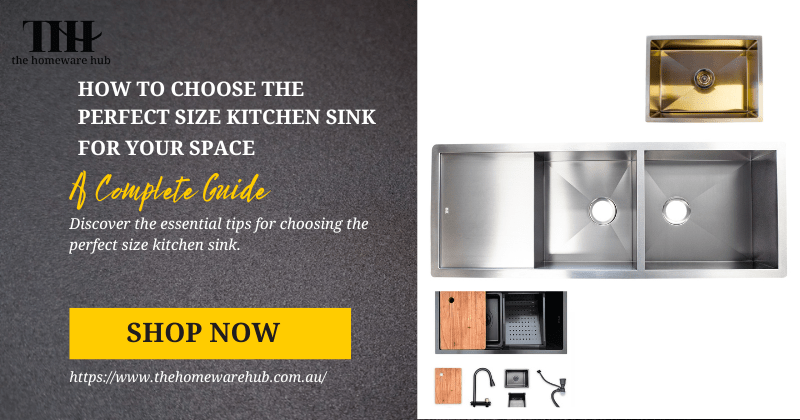How to Choose the Perfect Size Kitchen Sink for Your Space
Date Posted:28 November 2024
Selecting the right kitchen sink size is crucial for both functionality and aesthetics. A properly sized sink can streamline your kitchen tasks while complementing your overall design. Here’s a guide to help you make an informed choice:

1. Assess Your Kitchen Space
- Measure the Countertop Area: Determine how much counter space you can dedicate to a sink. Larger kitchens can accommodate bigger sinks, while smaller kitchens may require compact options.
- Consider Undermount or Drop-In Sinks: Undermount sinks save counter space, while drop-in sinks are easier to install in smaller spaces.
- Think About Workflow: Ensure there’s enough counter space on either side of the sink for prep work and drying dishes.
Check: What Are the Types of Kitchen Sink Faucets? A Comprehensive Guide
2. Understand Sink Dimensions
- Standard Sizes: Kitchen sinks typically range from 22 to 36 inches wide. Choose a size that fits your countertop without overpowering the space.
- Depth Considerations: Deeper sinks (9–12 inches) are great for large pots and pans but may reduce under-sink storage.
- Width-to-Cabinet Ratio: Ensure the sink size matches the width of the cabinet below it, leaving room for installation.
3. Choose the Right Bowl Configuration
- Single Bowl: Ideal for smaller kitchens or those who need a large, uninterrupted space for washing big items.
- Double Bowl: Perfect for multitasking, such as washing and rinsing simultaneously. Choose equal or offset bowl sizes based on your needs.
- Triple Bowl: Best for large kitchens or heavy-duty use, offering extra versatility for prep and cleaning.
Check: Understanding the Difference Between Kitchen and Bathroom Taps: A Complete Guide
4. Match Your Sink to Your Kitchen Style
- Material Options: Stainless steel is versatile and durable, while fireclay and cast iron offer a more traditional look.
- Shape and Edges: Rounded edges are easier to clean, while square edges give a modern, sleek appearance.
- Finish Coordination: Ensure the sink finish complements other kitchen elements, such as the faucet and appliances.
5. Optimize for Your Needs
- Cooking Habits: If you cook frequently, a larger sink with multiple bowls can enhance convenience.
- Family Size: A larger household may benefit from a wider sink for handling more dishes.
- Lifestyle Considerations: Compact sinks with integrated cutting boards or colanders are great for smaller kitchens or minimalist setups.
Check: Shop Kitchen Taps & Mixers Australia
6. Consider Maintenance and Cleaning
- Ease of Cleaning: Larger sinks with fewer crevices are easier to maintain.
- Material Durability: Stainless steel resists stains and scratches, while porcelain may require more care.
- Drain Placement: Offset drains provide more workspace and improve water drainage efficiency.
7. Plan for Plumbing and Accessories
- Check Plumbing Requirements: Ensure your sink choice matches existing plumbing or allows for easy modifications.
- Accessory Compatibility: Look for sinks with options for add-ons like drying racks, cutting boards, and soap dispensers.
- Under-Sink Storage: Factor in the space needed for garbage disposals or water filtration systems.
Check: How to Choose the Perfect Tapware for Your Kitchen Sink
8. Balance Budget and Quality
- Cost Range: Kitchen sinks vary widely in price, from budget-friendly stainless steel to premium stone or composite models.
- Durability vs. Cost: Investing in a durable sink can save you money on replacements and repairs in the long term.
- Warranty: Choose sinks with reliable warranties to ensure quality and peace of mind.
Upgrade Your Kitchen with the Perfect Sink
Finding the right size kitchen sink involves balancing space, functionality, and design. At The Homeware Hub, we offer a wide range of kitchen sinks to suit every need and style. Explore our collection to discover the perfect fit for your kitchen.
FAQs About Choosing the Right Kitchen Sink
1. What is the most popular kitchen sink size?
The standard size for most kitchens is 30-33 inches wide, offering a balance between functionality and space efficiency.
2. Can I install a larger sink in a small kitchen?
Yes, but ensure there’s enough countertop space left for other tasks. Compact single-bowl sinks or corner sinks are good alternatives.
3. Which material is best for a kitchen sink?
Stainless steel is durable and versatile, while fireclay and composite materials add elegance and durability for specific aesthetics.
4. How do I clean my kitchen sink?
Use non-abrasive cleaners for daily maintenance. For tougher stains, baking soda and vinegar work well on most materials.








